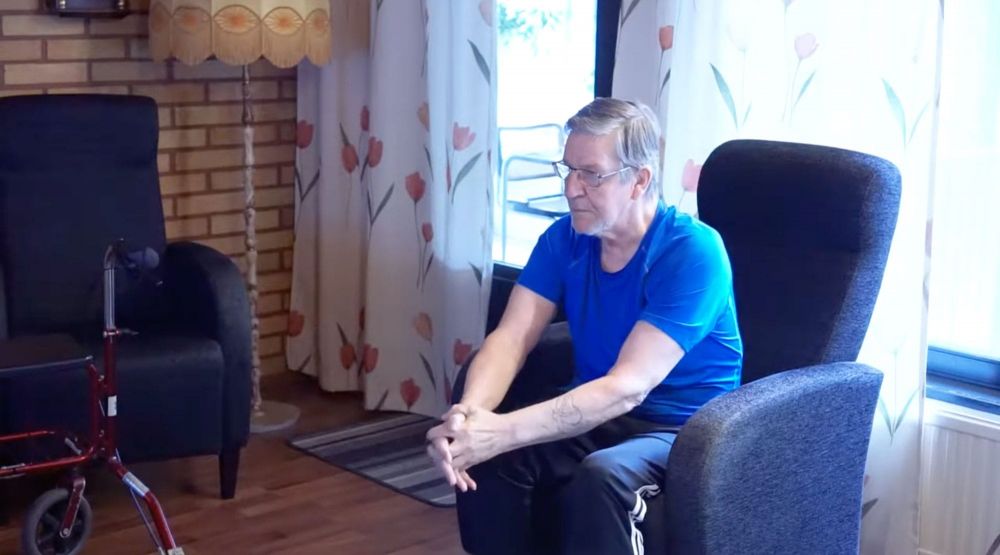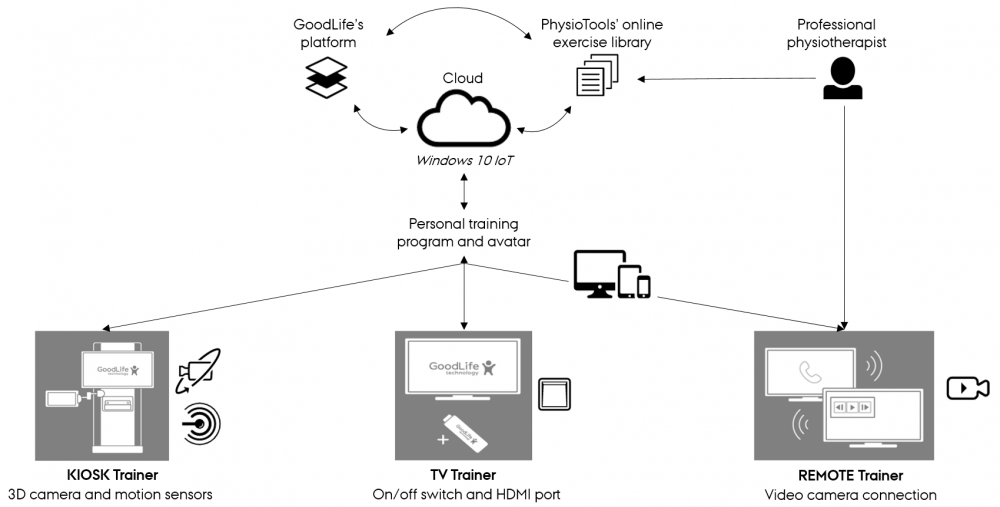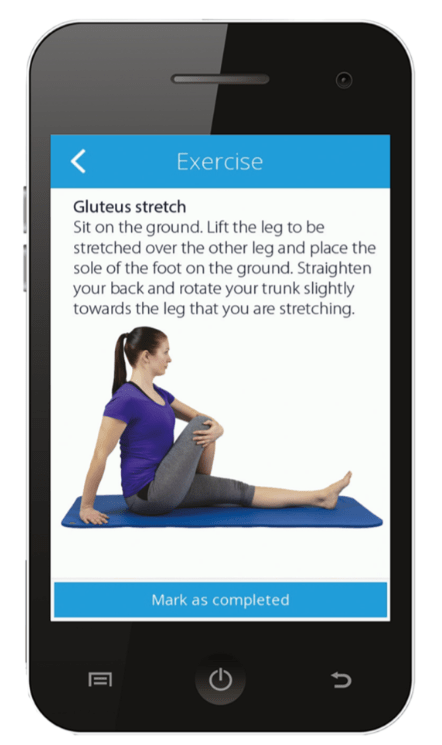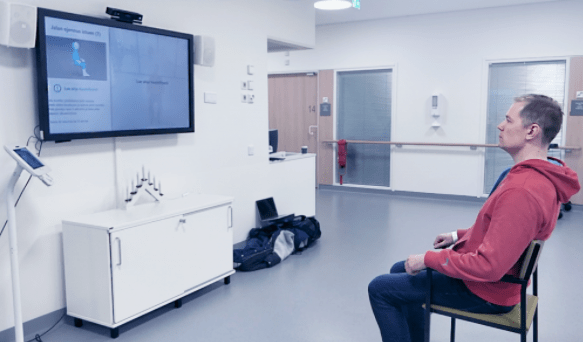
Quadible
ID: 3944
February 21, 2022
Artificial intelligence platform increases cybersecurity by authenticating users through behavioural patterns.
ID: 4482
September 15, 2022
GoodLife Technology offers a mobile solution that supports physical rehabilitation. By digitalising physical therapy, the company is transforming the customer experience of traditional rehabilitation processes through a range of products with interactive software that is built on principles from the video game industry.
Founded in 2013, GoodLife is as a spin off from the established game development company Nitro Games. The company is based in Kotka, Finland, and of 2022, the team is comprised of seven dedicated game design veterans that are on a mission to improve physiotherapeutic care processes for better rehabilitation outcomes.

The solution covers the GoodLife Trainer product family and a proprietary software platform, through which the company disseminates virtual physical therapy sessions and exercise guidance that helps patients to comply with their personal training programs. The solution is based on professional content and monitors physical progress to enhance independent training motivation. The Trainer product family facilitates in- and outpatient care that enables a seamless and coherent patient experience and supports the full rehabilitation journey of the patient from hospital to home.
GoodLife serves the needs of physical rehabilitation patients as well as those who provide rehabilitation services, such as physiotherapists and their institutional affiliates, including hospitals, health clinics, and supporting care professionals.

The incentive of GoodLife to develop their IoT solution derives from the global concern of rapid aging populations. The shift in demographics is a challenge because it greatly reduces the physical ability of the people, and accordingly increases social and healthcare costs to an extent that jeopardizes our current institutional arrangements. This concern generates a worldwide demand for solutions that can enrich physical health and welfare to accede to the populate restructuring ahead.
GoodLife responds to this demand by accelerating physical rehabilitation processes through a digital disruption of traditional physiotherapeutic care. This is effectuated in a solution that relies on technology to mediate the care service, providing less reliance on human facilitation and more flexibility both for the care professional and the rehabilitation patient. Hence, GoodLife’s solution supports the physical rehabilitation process by contributing to increasing health and wellbeing of patients with the help of technology.
“All the things that you would do in front of your physical therapist, we try to use technology to help that.”
Janne Niittymaki, Chief Technology Officer and Founder of GoodLife Technology
The key to efficacious rehabilitation is to follow the instructions given by the physiotherapist as closely as possible. In most cases, when people are recovering after a trauma or surgery, a therapist will recommend to do specific exercises on daily basis. However, not all patients do so. This is the biggest challenge in physical rehabilitation processes – patients’ non-adherence with prescribed instructions when training independently. As result, recovery processes become long and expensive and health outcomes may be worsened.
Here seems to be a paradox, as it is to be assumed that the rehabilitation patients are the ones most interested in fast and effective recovery. However, patients are not always sure if they are following the instructions correctly, and if unable to see and feel progress in their physical health, patience, enthusiasm, and hope declines. Hence, a clear need exists for new consumer-centric solutions to motivate and help patients to comply with their rehabilitation training programmes.

The first building blocks of GoodLife were laid years prior to the foundation of the company, when the founders-to-be were working at a start-up called Nitro Games, developing video games for PC, PlayStation, and Xbox. One unit of the business focused on broadening the application of the video game concept to new environments and extend the purpose of the technology beyond entertainment — and the team started creating projects for schools, libraries, museums, and science parks. One project, developed together with a local health provider, was a graphic game for stroke survivors. A game was developed based on sensing the movements of bodies, and the idea was to activate core muscles to support patients learning to walk again. Both patients and therapists liked the game as it made rehabilitation seem less of a burden and more fun and it could make the user repeat certain movements over 300 times in a few minutes.
This project led the founders to realise their passion in applying the expertise they possess in creating video games to develop solutions that can help people and add value to human health. In 2013, GoodLife Technology was founded with the aim to change people’s thinking about physical rehabilitation.
“We see ourselves like game industry veterans, thinking: how can we use the same technology, same business logic, same consumer logic, for doing something else?”
Janne Niittymaki, Chief Technology Officer and Founder of GoodLife Technology
GoodLife started building a platform based on the ingrained principles from the video game industry and entered into a collaboration with PhysioTools, the world’s leading physiotherapy software developer, to be at the forefront with the content of the services. Together, they developed a mobile application to replace paper handouts to physiotherapy patients and to encourage remote exercise. At present, this solution is being used worldwide. The successful acceptance confirmed GoodLife’s assumption about the vast potential of digitalisation in rehabilitation processes, and that, if equipped with the right tools, patients are in fact able and willing to actively engage in their own rehabilitation. Based on this, GoodLife decided to build a personalised physical therapy solution that suits the needs of the individual patient and adds value to service providers. In 2015, the company launched the first GoodLife Trainer product, The KIOSK Trainer. Grounded in a desire to bring the service to the users, GoodLife engaged in the ACTIVAGE project in 2018, which became a valuable aid to scale the business and to develop an entire family of products for independent training and individual rehabilitation. These efforts even led GoodLife to win an award for the best solution in ACTIVAGE, a project under the auspices of the H2020 framework of the European Commission with 49 participating organisations.
GoodLife’s Trainer product family provides a range of options for physical rehabilitation that are all raising the activity level and engagement of patients to perform exercise instructions given by a physiotherapist. The options include the KIOSK Trainer that provides virtually controlled training with guided exercises, the REMOTE Trainer that facilitates online physical therapy sessions, and the TV Trainer that provides a personalised TV-channel with rehabilitation exercises. Hence, with the Trainer product family, GoodLife enables digitalisation of physiotherapy throughout the full rehabilitation journey.

The solution that drives the digitalisation, and is the foundation for the Trainer product family, is Goodlife’s proprietary software platform. This platform is hosted in the cloud from where it connects (via 4G, Wi-Fi, Ethernet, or whatever connection available) to the products and provides the operating system in terms of Microsoft 10 IoT [1].
“We are coming from outside of the industry – from the game industry, which is leading in software – and are going into an industry, which is not so advanced in software technology.”
Hannu Vuola, Chair of the Board & Founder of GoodLife Technology
GoodLife’s platform integrates with the PhysioTools software program that provides access to a comprehensive library of online exercises and exercise guidance. This integration allows professional physiotherapists to design training programmes and illustrate the exercises with a trainer avatar. The training program and the avatar can be personalized to fit the needs of the individual patient, and the exercises can be performed on-demand without the need for physical presence and guidance from the physiotherapist. GoodLife’s platform further supports data collection throughout the virtual session in order to track everything from single movements to the progress of the full rehabilitation program . Algorithms compare the input data against animated reference moves and processes the information to output data that guides patients on how to exercise correctly according to their personal training program. The specific data in and output, and the consumer experience, rely on the specific Trainer product.

Kiosk Trainer: Offers independent rehabilitation training with guided exercises 24/7. The product functions as a virtual physiotherapist, which is able to monitor patients as they perform exercises, correcting and guiding them through a training session. The product is designed for use in hospitals, clinics, and assisted living communities to help raise the activity levels of rehabilitation patients without requiring the physical presence of the physiotherapists. The physical components to the product are a screen, a tablet user interface, a 3D camera, and a motion sensor system (Microsoft Kinect) combined into a stationary installation. The KIOSK Trainer connects to the GoodLife platform, enabling it to visualise both generic and personal training programs.
TV Trainer: Offers a user experience similar to the KIOSK Trainer, but on the premise of the patient. This product is first and foremost designed to be used in homes but can be deployed at assisted living facilities, hospitals, and clinics. The physical components to the product are an HDMI port and an on/off switch. The HDMI port is plugged into a TV, computer, or any other screen, enabling the device to connect to the GoodLife Platform. The single-button switch serves a simple interface, and when clicked by the patient, turns on or off a personalised TV-channel with physical rehabilitation exercises. The TV Trainer is a standalone single purpose product that is highly versatile and easy to use for patients and for physiotherapists to deliver and update training programs. The service is able to function in offline mode and needs an online connection only when the training program is being updated by the physiotherapist.
Remote Trainer: Offers a means to enhance the experience and usability of online based physical therapy sessions. The product enables physiotherapists to guide patients remotely over a video connection, illustrating exercises with the avatar while monitoring the patient perform of those exercises. This product is designed to be used in homes but can be deployed in any situation where the physiotherapist is physically distant from the patient. There are no physical components to the product besides the interface for the video call, which could be a computer, tablet, mobile phone, or any device having a screen and a video camera connection. GoodLife leverages existing video telephony software programs, such as Microsoft Teams and Zoom, and integrates them with their platform solution to deliver this micro service product. The usability of the micro service is just as simple as the macro service video call, but does moreover support virtually guided interactive exercising.

The portfolio of Trainer products have been selected and developed based on experiments on how to best deliver the physiotherapeutic service. The core concept for these experiments has been to define the most optimal way for the patient to receive training programmes and single exercise updates assigned by the professional. Whether it is on a KIOSK, TV, desktop, mobile, or via a tele-health session, is contingent by the health state and preference of the individual patient as well as the inclination of the intermediate customer.
“The IoT gives us access to go closer to those customers that are really difficult to reach in normal consumer devices… IoT gives us the advantage of offering easy-to-use solutions.”
Janne Niittymaki, Chief Technology Officer and Founder of GoodLife Technology
All the GoodLife Trainer products are designed to be user-friendly and accessible for all people regardless of technological skills. Furthermore, they are compatible with the most widely used third-party devices, systems, and software deployed in the domain.
The development of GoodLife’s IoT solution is a direct response to the concern of globally deteriorating physical health and wellbeing due to the accelerating demographical restructuring and a contribution to configuring more future proof and robust societies to cope with this. By leveraging technology in rehabilitation processes, GoodLife has designed an intelligent, and yet simple, solution that digitalises physiotherapeutic care – not to replace traditional human facilitated rehabilitation, but to support it with the enablement of a hybrid experience. The digital experience is more than ever a uniting means between convenience and quality of service for rehabilitation patients, their physio therapists, and the institutional service providers.
“This is doing common good, not just for GoodLife products, but this is something that we do for the industry. It must happen! It is not just us having the problem, the needs go wide.”
Janne Niittymaki, Chief Technology Officer and Founder of GoodLife Technology
Although GoodLife finds physiotherapists to be habitually conservative, preferring to be physically present for sessions, the company attributes great importance to the dissemination of awareness that these kinds of technologies and solutions exists. To this end, the constant advent of new generations in the external market and the resolute culture of the internal team is key. Hence, understanding purpose and capabilities of the solution is fundamental to truly recognise the value of availability and use. Fortunately, the acceleration in the digitalisation trend and heavy increase in the number of online users has led consumers and professionals to increasingly understand and recognise the value of being able to interact and serve digitally.
The service is delivered through the digital platform, where the Trainer products provide a user interface that enables the complete service experience of being served with a physiotherapy session and exercise content and with minimum effort for the service provider. This value of the experience derives from a range of unique traits:
“Sometimes IoT and embedded systems are really parallel and close to each other. If we can use the same unit for multiple purposes, then we are all winning.”
Janne Niittymaki, Chief Technology Officer and Founder of GoodLife Technology
Ease of use: GoodLife puts pride in offering a solution with easy and intuitive usability. Focus should not be on learning new technology, but on performing the exercises. Therefore, technology should not be a feature itself, but it should help contribute to enhancing the core service. This is particularly relevant as rehabilitation patients often are elderly, whom are typically not technology savvy.

An increasing demand for GoodLife’s solution is manifested as outcome in a transformation that has enabled the company to add a range of products for delivery of the rehabilitation service being mediated in a SaaS[2] solution, generating company growth as an outcome. GoodLife generates profit from a recurring revenue mechanism, where customers are charged via subscription to ensure close collaboration and continuous feedback.
Users of GoodLife’s solution are the physical rehabilitation patients as well as the individual physiotherapists that provide the rehabilitation service. The customers are the institutional providers of the service, which may be both private and public organisations across domains that are mandated to provide physical rehabilitation. The current majority are constituted by public health clinics, hospitals, and supportive care professionals. GoodLife’s solution generates beneficial outcomes that, although all arise from the unique traits, are individual for each user segment. These outcomes are compiled and summarised here:
Patients
Physio therapists
Institutional service providers
The majority of GoodLife’s customers are based in the Nordics, with prominence in Finland, where the company seeks to build solid reference cases and results on the home market to scale the business abroad. Some of the latest traction metrics cover 7 clinics and 3 pilots, with examples such as Espoo City Hospital, now able to provide their clients with a possibility to exercise independently with the KIOSK Trainer, which has raised the active time of patients substantially. Service Center Helsinki is now able to provide their elderly home care clients the possibility to receive video-based remote therapy at home, which is 16 times cheaper than physical appointments.
Conclusively, GoodLife’s solution helps to accelerate physical rehabilitation processes through a digital disruption of the traditional physiotherapeutic care. As game veterans, the company transforms the customer experience as well as the delivery of the service in a way that enriches physical health and welfare. This ultimately increases physical capabilities of the people, and accordingly decreases social and healthcare costs of societies.
Since GoodLife introduced the idea of a hybrid rehabilitation process with IoT to support traditional physical therapy sessions, many challenges have been faced and valuable learnings have transpired. Looking back, the company recalls a persistent challenge in getting the market to understand and accept the value proposition of their solution. As it is a supportive solution to the core service, GoodLife heavily relies on building and communicating a use case around the added value that digitalisation can provide to physiotherapeutic care. The value proposition lies in the delivery of the core service, not in the technology solution itself.
“It was difficult. It is difficult. It will be difficult. I am an innovator and engineer by DNA. For me it is easy to create these doohickey devices that can solve this and that problem. But it is really difficult to adapt that into a real use case.”
Janne Niittymaki, Chief Technology Officer and Founder of GoodLife Technology
Hence, for users and customers to leverage the full value of GoodLife’s solution, it first and foremost prerequisites that the core service is impeccable. A valuable learning for the company in this regard has been the importance of building a system of partners, in particular the physiotherapists and other care professionals, that enables the solution to deliver this impeccable quality of the core service. Secondly, it requires that the technology solution is adapted into a use case, which has emphasised the significance of having diverse profiles on the internal team that are not only able to innovate and develop, but also to communicate and operationalise.
GoodLife considers a number of points to be vital for the success of the solution. Taking departure in the development and commercialisation of the software platform and the Trainer products, these points are compiled into a list of recommendations below:
1. Collaborate and outsource to build core capabilities
An essential point made by GoodLife is that they are a provider of technology. Isolating and recognising the difference between providing the technology and the content of a service is crucial.
“Without the content we are nothing. …But if we should also focus on content, there is no way on Earth that this kind of business would survive. Then we would be competing against them – now we are running with them.”
Janne Niittymaki, Chief Technology Officer and Founder of GoodLife Technology
Them, referring to the software providers of the exercises and training programs – PhysioTools and Physitrack, are vital partners to deliver the contents of GoodLife’s solution. Hence, a key recommendation to IoT Innovators is to focus on the core capability of providing the technology service and outsource the ambient rest. For GoodLife, this philosophy institutes a natural openness to any potential collaboration.
2. Develop iteratively and escape preconceived thinking
“Expose your product early and expose your product often. Learn from it, and then go back to the office, and do some more. It should be iterations.”
Janne Niittymaki, Chief Technology Officer and Founder of GoodLife Technology
From experience, GoodLife is confident that any IoT development process must be iterative to become successful. Only by testing, you learn to improve. In fact, the Trainer product family is the iterative aftermath up to 10-15 prototype products that have been abandoned. GoodLife puts emphasis on not having preconceived ideas on how to solve client problems, as it may hinder outside-the-box thinking. Instead, they recommend IoT innovators to be open, encourage clients to do the talking, and focus on listening, learning, and adapting.
“A healthy approach for us when we jump into a new project with a new client is that we do not know anything about it. We consider ourselves outsiders but with a set of tools and skills.”
Janne Niittymaki, Chief Technology Officer and Founder of GoodLife Technology
3. Understand your market
Being the provider of the technology rather than the provider of the service, GoodLife does not interact with the users and customers of their solution by default. When shifting from the domain of gaming and entertainment and entering the domain of health and rehabilitation, GoodLife did not have much experience or particular knowledge of the market. Only by talking to rehabilitation patients, physio therapists, health clinics, hospitals, and supportive care professionals, they were able to understand the problems encountered by the various actors of the market and develop a solution that address them.
“If we are sitting in the office there is no way on Earth that we can actually figure out what they need. …So therefore, we need to be close with the clients.”
Janne Niittymaki, Chief Technology Officer and Founder of GoodLife Technology
Not knowing what forces that drive the market could be fatal for any business. For IoT innovators to achieve success in new markets, GoodLife advises to actively and frequently reach out to the users and customers to collect feedback on what is working in the solution and what is not.
4. Reach scale through multi-compatibility and service focuses
Adding service functionalities to a solution is oftentimes more valuable than adding devices and being able to deliver those same features across platforms and devices, not just your own but the ones that are publicly available, has in the case of GoodLife provided huge benefits both for the users, the customers, and the commercial company growth. Hence, for IoT innovators that have a platform for how to deliver the service experience in place, multi-device compatibility can provide the concept for how to scale it.
“It is not just about providing the hardware, it is about providing the service.”
Janne Niittymaki, Chief Technology Officer and Founder of GoodLife Technology

Illustration 6: Digital Maturity Radar Chart: Assessment of GoodLife Technology by Janne Niittymaki, CTO and Founder.
GoodLife Technology assumes a high level of digital maturity with an overall score of 4.69. The score indicates that the digital capabilities of the company are vastly mature, and that they perform above average for the sector.
The Digital Maturity Assessment Tool is copyrighted by Associate Professor and PhD Annabeth Aagaard, Director at the Interdisciplinary Centre for Digital Business Development, Aarhus University. To get the digital maturity of your company mapped out, click here.
[1] Microsoft 10 IoT: Operating System that is a member of the Windows product family and that bring enterprise-class power, security and manageability to the Internet of Things.
[2] Software as a Service.

Copyright notice: © 2020 – 2023 EU-IoT Consortium.
This material was produced as part of the EU-IoT project, grant ID 956671, and is funded by the Horizon 2020 Framework Programme under topic ID ICT-56-2020.
EU-IoT is the European IoT Hub. The EU-IoT project works towards growing a sustainable and comprehensive ecosystem for Next Generation Internet of Things.
Source of origin: Information to document this use case originates from the H2020 call: IoT-01-2016 Large Scale Pilots (IA); Project ACTIVAGE 732679; Period: 01-01-2017 to 30-09-2020; EC contribution 2.6 mil. EUR.
